
Earl of Winchilsea is a title in the Peerage of England held by the Finch-Hatton family. It has been united with the title of Earl of Nottingham under a single holder since 1729. The Finch family is believed to be descended from Henry FitzHerbert, Lord Chamberlain to Henry I. The name change to Finch came in the 1350s after marriage to an heiress by a member of the Finch family. In 1660 the 3rd Earl of Winchilsea was created Baron FitzHerbert of Eastwell, Kent, in recompense for his efficient aid in the Restoration of the Monarchy. The Herbert family of Wales, Earls of Pembroke, share common ancestry but bear differenced arms. A later member of the family, Sir William Finch, was knighted in 1513. His son Sir Thomas Finch, was also knighted for his share in suppressing Sir Thomas Wyatt's insurrection against Queen Mary I, and was the son-in-law of Sir Thomas Moyle, some of whose lands Finch's wife inherited. Thomas's eldest son Moyle Finch represented Weymouth, Kent and Winchelsea in the House of Commons. In 1611 he was created a baronet, of Eastwell in the County of Kent.

Earl of Aylesford, in the County of Kent, is a title in the Peerage of Great Britain. It was created in 1714 for the lawyer and politician Heneage Finch, 1st Baron Guernsey. He had already been created Baron Guernsey in the Peerage of England in 1703. Finch was the younger son of Heneage Finch, 1st Earl of Nottingham and the great-grandson of Elizabeth Heneage, 1st Countess of Winchilsea. Lord Aylesford's eldest son, the second Earl, represented Maidstone and Surrey in Parliament. In 1712, he married Mary Fisher, daughter of Sir Clement Fisher, 3rd Baronet. Through this marriage Packington Hall in Warwickshire came into the Finch family. Their son, the third Earl, sat as a Member of Parliament for Leicestershire and Maidstone. His eldest son, the fourth Earl, represented Castle Rising and Maidstone in the House of Commons, and after entering the House of Lords on his father's death, served as Captain of the Yeomen of the Guard from 1783 to 1804 and as Lord Steward of the Household from 1804 to 1812.

Earl of Chichester is a title that has been created three times, twice in the Peerage of England and once in the Peerage of the United Kingdom. The current title was created in the Peerage of the United Kingdom in 1801 for Thomas Pelham, 2nd Baron Pelham of Stanmer.
Earl of Bradford is a title that has been created twice, once in the Peerage of England and once in the Peerage of the United Kingdom. It was first created in 1694 for Francis Newport, 2nd Baron Newport. However, all the Newport titles became extinct on the death of the fourth Earl in 1762. The earldom was revived in 1815 for Orlando Bridgeman, 2nd Baron Bradford. The Bridgeman family had previously succeeded to the Newport estates. The title of the peerage refers to the ancient hundred of Bradford in Shropshire, and not, as might be assumed, to the city of Bradford, Yorkshire, or the town of Bradford-on-Avon in Wiltshire.

Fawsley is a hamlet and civil parish in West Northamptonshire, England. The population at the 2001 census was 32. At the 2011 census the population remained less than 100 and is included in the civil parish of Charwelton.
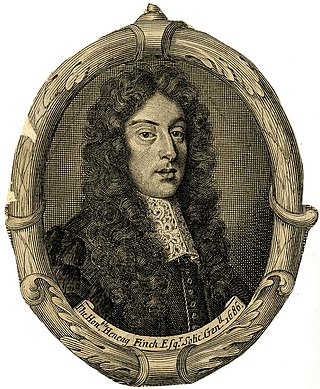
Heneage Finch, 1st Earl of Aylesford, PC, KC was an English lawyer and statesman.

The Verney family purchased the manor of Middle Claydon in Buckinghamshire, England, in the 1460s and still resides there today at the manor house known as Claydon House. This family had been seated previously at Fleetmarston in Buckinghamshire then at Pendley in Hertfordshire. It is not to be confused with the unrelated but also ancient and prominent Verney family of Compton Verney in Warwickshire.

Compton Verney is a parish and historic manor in the county of Warwickshire, England. The population taken at the 2011 census was 119. The surviving manor house is the Georgian mansion Compton Verney House.

There have been two baronetcies created for members of the Knightley family, one in the Baronetage of England and one in the Baronetage of Great Britain. Both creations are extinct. The Knightley family originated at the Staffordshire manor of Knightley, acquired by them shortly after the Norman Conquest of 1066. In 1415 Sir Richard Knightley purchased the manor of Fawsley in Northamptonshire, where the senior line of the family became seated.

Rainald Knightley, 1st Baron Knightley, known as Sir Rainald Knightley, 3rd Baronet, from 1864 to 1892, was a British Conservative Party politician.
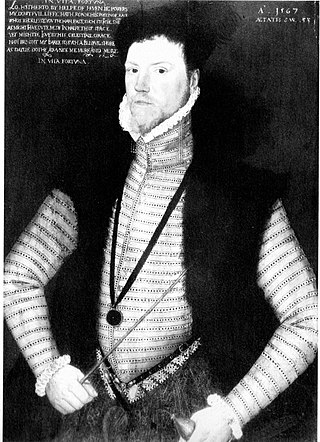
Sir Richard Knightley of Fawsley Hall in Northamptonshire was an English Member of Parliament (MP) and leading patron of the Puritans during the reign of Elizabeth I. The Knightleys were one of the leading families of Northamptonshire.

Charles James Murray was a British Conservative Party politician and diplomat.
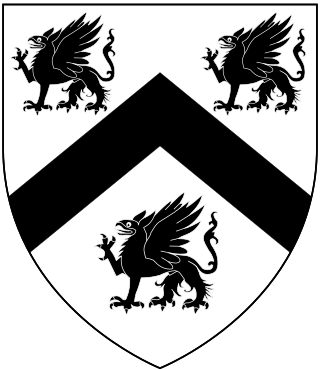
Heneage Finch, 6th Earl of Aylesford DL, styled Lord Guernsey until 1859, was a British peer and politician.

Edward Conway, 1st Earl of Conway PC, FRS, of Ragley Hall, Alcester, in Warwickshire, was an English peer and politician who served as Secretary of State for the Northern Department between 1681 and 1683.

Heneage Finch, 2nd Earl of Aylesford (1683–1757) was a British peer and member of the House of Lords, styled Lord Guernsey from 1714 to 1719.

Heneage Finch, 3rd Earl of Aylesford, styled Lord Guernsey between 1719 and 1757, was a British peer and politician.
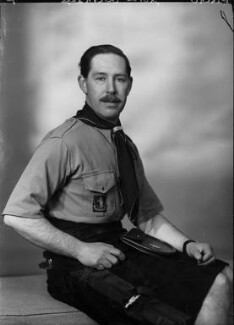
Charles Ian Finch-Knightley, 11th Earl of Aylesford,, styled Lord Guernsey between 1940 and 1958, was a British peer.
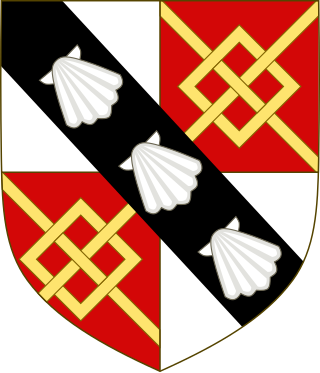
Sir John Spencer was an English nobleman, politician, knight, sheriff, landowner, and Member of Parliament. He was an early member of the Spencer family.
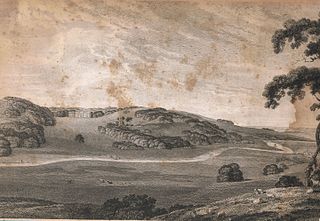
The historic manor of Tawstock was situated in North Devon, in the hundred of Fremington, 2 miles south of Barnstaple, England. According to Pole the feudal baron of Barnstaple Henry de Tracy made Tawstock his seat, apparently having abandoned Barnstaple Castle as the chief residence of the barony. Many of the historic lords of the manor are commemorated by monuments in St Peter's Church, the parish church of Tawstock which in the opinion of Pevsner contains "the best collection in the county apart from those in the cathedral", and in the opinion of Hoskins "contains the finest collection of monuments in Devon and one of the most notable in England".

John Corbet (1751–1817) of Sundorne, was an English sportsman of the Shropshire landed gentry and politician who sat in the House of Commons from 1775 to 1780.

























